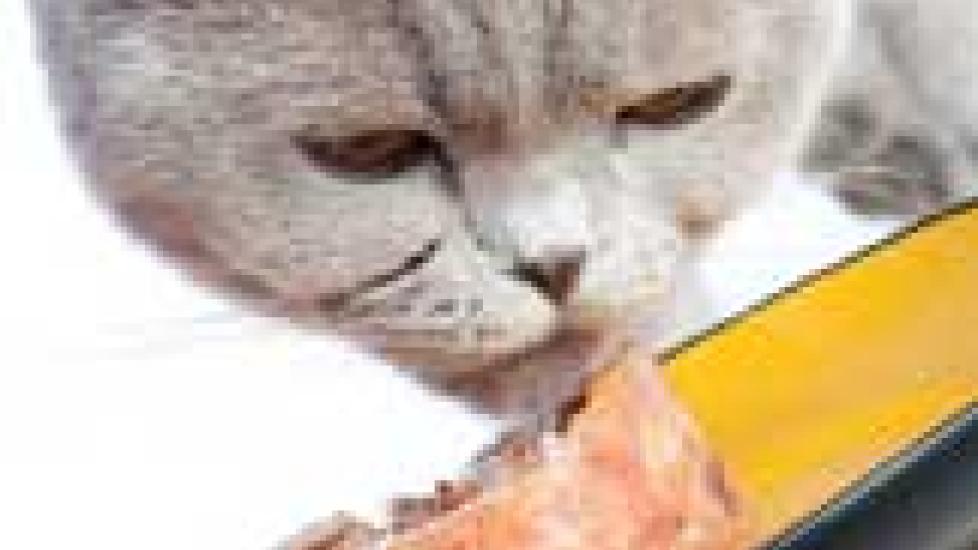Feeding Strategies for Overweight Cats
Previously we discussed the complications of feeding the overweight cat, especially in the multi-cat setting. Today I would like to offer strategies for the single and multi-cat households.
We need to thank Dr. Mark Brady for his contribution to Practical Weight Management in Dogs and Cats, by Dr. Todd Towell, for the core of these ideas.
The Single Cat Household
The overweight cat with an ideal body weight of 10 pounds needs about 200-225 calories (kcal) per day. The calorie needs for cats with smaller or larger ideal weights is:
(30 x Ideal Weight (lbs.) ÷ 2.2) + 70 = Calories (kcal) per day
(Reminder: Consult your vet before starting any weight loss program.)
A possible strategy for owners who work at home or are able to be with their cats all day is to offer 6-7 scheduled feedings of 30-35 calories of canned food, dry food, or a combination. An easier strategy is to feed two scheduled feedings of 30-35 calories and place the remaining 140-150 calories in four feeding stations, food balls or food puzzles throughout the house or apartment. Locations that require climbing or effort are ideal. This encourages burning energy to obtain food (the modern version of "the hunt").
Canned or wet food scheduled meals and dry food feeding stations also work well. A third strategy is to place all of the daily calories in food stations for free feeding.
If offering treats is an essential part of the daily routine, the number of calories in the treats needs to be subtracted from the scheduled feedings and calorie counts from the feeding stations.
This strategy requires a kitchen gram scale in order to accurately dispense scheduled feeding and food station allotments. The energy content of the food, wet or dry, must be known. If it is not on the container label it can be found on the company website; it is the kcal/kg for the food.
The daily food requirement is then determined by the formula:
Daily Calories ÷ kcal/kg) x 1000 = grams fed per day
The total number of grams is evenly distributed among the scheduled meals and feed stations. Using cans and cups to measure portions is not as accurate. Accuracy is important for weight loss.
The Multi-Cat Household
The actual strategies for multiple cats are the same as above. The difference is the total calorie count for the household, which is calculated and then divided between scheduled feedings and food stations. The calorie requirement for overweight cats or overweight prone cats is the same as above:
(30 x Ideal Weight (lbs.) ÷ 2.2) + 70 = kcal per day
For normal weight, less active cats use the formula:
[(30 X Weight (lbs.) ÷ 2.2) + 70] x 1.2 = kcal per day
For active or unneutered cats the formula is:
[(30 x Weight (lbs.) ÷ 2.2) + 70] x 1.5 = kcal per day
The daily calorie requirements for all cats are totaled. One-quarter to one-third of the total calories are divided between two scheduled feedings. The remaining calories are divided evenly among feeding stations.
Allow a minimum of 2-3 more stations than the total number of cats. The quantity (in grams) of food is calculated with the same formula used for single cat households.
Example:
In a 3-cat home
1 13lb overweight cat with an ideal wt. of 10lbs
1 normal 10lb less active cat
1 very active 10lb cat
Overweight cat:
(30 x 10 2.2) + 70 = 206 kcal/day
Less active cat:
[(30 x 10 2.2) + 70] x 1.2 = 247 kcal/day
Active cat:
[(30 x 10 2.2) + 70] x 1.5 = 309 kcal/day
Total Daily Calories = 762 kcal/day
One-third of the 762 kcal (228 kcal) is divided between two meals (114 kcal). So at each feeding, each cat gets about 38 calories (114 ÷ 3). The remaining 534 calories are divided among seven feeding stations; each station will contain about 75 calories.
I must admit that these strategies are more successful for prevention of obesity or stabilizing existing household weights. Weight loss, if achieved at all, is a slow, long process, and owners lose their enthusiasm for the strategy over time. Single cat households experience the most success. Prevention is definitely the best solution for the cat.
What strategies have been successful for you?

Dr. Ken Tudor
Image: mashe / via Shutterstock’
